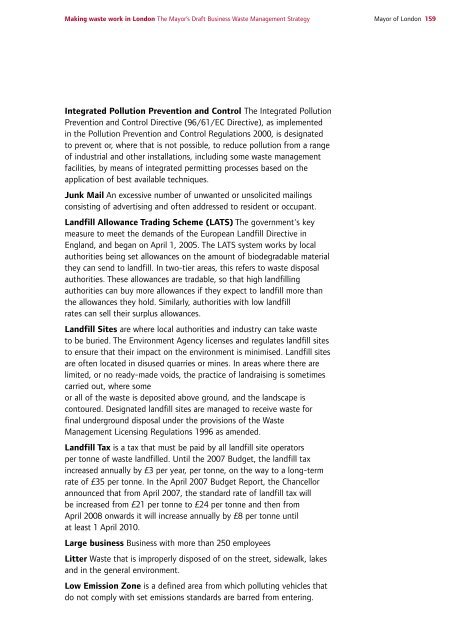Draft Business Waste Strategy PDF - london.gov.uk - Greater ...
Draft Business Waste Strategy PDF - london.gov.uk - Greater ...
Draft Business Waste Strategy PDF - london.gov.uk - Greater ...
You also want an ePaper? Increase the reach of your titles
YUMPU automatically turns print PDFs into web optimized ePapers that Google loves.
Making waste work in London The Mayor’s <strong>Draft</strong> <strong>Business</strong> <strong>Waste</strong> Management <strong>Strategy</strong> Mayor of London 159<br />
Integrated Pollution Prevention and Control The Integrated Pollution<br />
Prevention and Control Directive (96/61/EC Directive), as implemented<br />
in the Pollution Prevention and Control Regulations 2000, is designated<br />
to prevent or, where that is not possible, to reduce pollution from a range<br />
of industrial and other installations, including some waste management<br />
facilities, by means of integrated permitting processes based on the<br />
application of best available techniques.<br />
Junk Mail An excessive number of unwanted or unsolicited mailings<br />
consisting of advertising and often addressed to resident or occupant.<br />
Landfill Allowance Trading Scheme (LATS) The <strong>gov</strong>ernment's key<br />
measure to meet the demands of the European Landfill Directive in<br />
England, and began on April 1, 2005. The LATS system works by local<br />
authorities being set allowances on the amount of biodegradable material<br />
they can send to landfill. In two-tier areas, this refers to waste disposal<br />
authorities. These allowances are tradable, so that high landfilling<br />
authorities can buy more allowances if they expect to landfill more than<br />
the allowances they hold. Similarly, authorities with low landfill<br />
rates can sell their surplus allowances.<br />
Landfill Sites are where local authorities and industry can take waste<br />
to be buried. The Environment Agency licenses and regulates landfill sites<br />
to ensure that their impact on the environment is minimised. Landfill sites<br />
are often located in disused quarries or mines. In areas where there are<br />
limited, or no ready-made voids, the practice of landraising is sometimes<br />
carried out, where some<br />
or all of the waste is deposited above ground, and the landscape is<br />
contoured. Designated landfill sites are managed to receive waste for<br />
final underground disposal under the provisions of the <strong>Waste</strong><br />
Management Licensing Regulations 1996 as amended.<br />
Landfill Tax is a tax that must be paid by all landfill site operators<br />
per tonne of waste landfilled. Until the 2007 Budget, the landfill tax<br />
increased annually by £3 per year, per tonne, on the way to a long-term<br />
rate of £35 per tonne. In the April 2007 Budget Report, the Chancellor<br />
announced that from April 2007, the standard rate of landfill tax will<br />
be increased from £21 per tonne to £24 per tonne and then from<br />
April 2008 onwards it will increase annually by £8 per tonne until<br />
at least 1 April 2010.<br />
Large business <strong>Business</strong> with more than 250 employees<br />
Litter <strong>Waste</strong> that is improperly disposed of on the street, sidewalk, lakes<br />
and in the general environment.<br />
Low Emission Zone is a defined area from which polluting vehicles that<br />
do not comply with set emissions standards are barred from entering.
















